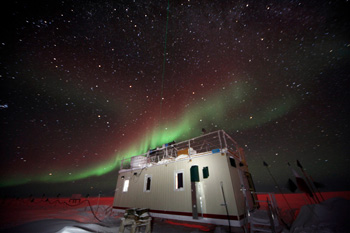A .gov website belongs to an official government organization in the United States.
A lock () or https:// means you've safely connected to the .gov website. Share sensitive information only on official, secure websites.
14 April 2011

Ryan Neely received one of the Outstanding Student Paper Awards at last December's Fall meeting of the American Geophysical Union. The paper was titled "Initial Results of the Cloud, Aerosol Polarization and Backscatter Lidar at Summit, Greenland." The paper describes the cutting edge polarization techniques Neely and colleagues employed with the Cloud, Aerosol Polarization and Backscatter Lidar (CAPABL). These new techniques included methods that attempt to measure particle orientation and allow for more accurate measurements of cloud depolarization ratio, as well as making observations of aerosol backscatter.
Neely is a PhD candidate at the University of Colorado working with Dr. Jeffery Thayer's Active Remote Sensing Laboratory and Dr. Brian Toon's Aerosol Research group. At NOAA, he is working with Susan Solomon's Chemistry and Climate Processes group in CSD on modeling stratospheric aerosols, and with the Observatory Operations group in GMD on analysis of data from aerosol lidars.
Measurements of cloud properties over Summit, Greenland are necessary to document the full range of cloud conditions and characteristics throughout the Arctic. A new lidar system has been developed to measure depolarization and backscatter of clouds in the lower troposphere and aerosols in the upper troposphere and lower stratosphere. This lidar uses recent developments in optical methods to characterize system polarization effects in order to compensate for systematic phase shifts. The lidar utilizes the detection of three polarization planes to determine the depolarization ratio and diattenuation of clouds and aerosols below 2.5% error. The ability to measure diattenuation allows for a qualitative assessment of particle orientation and analysis of the data that can forego the assumption of randomly oriented particles. The lidar is located at Summit, Greenland as part of the Integrated Characterization of Energy, Clouds, Atmospheric State, and Precipitation at Summit project and NOAA's Global Monitoring Division's stratospheric lidar network. Initial results from the first six months of operation suggest cloud formation similar to other Arctic sites. Here we particularly look at the persistence of mixed phase clouds and new results suggesting possible ice crystal alignment under certain atmospheric conditions.